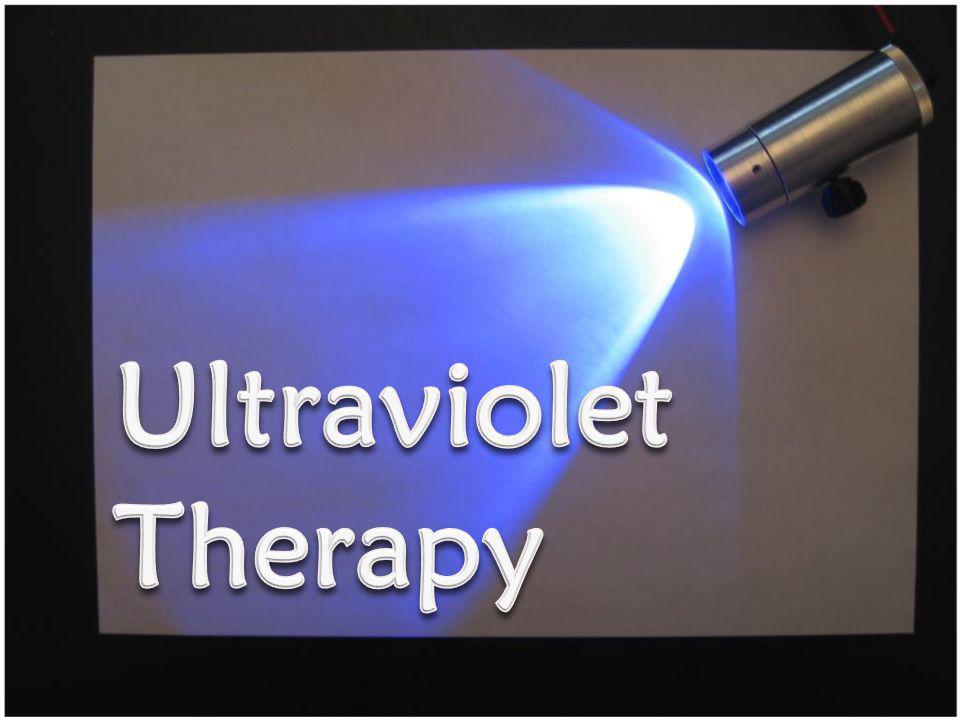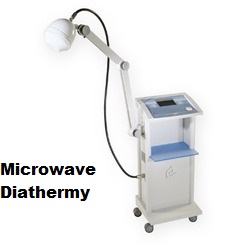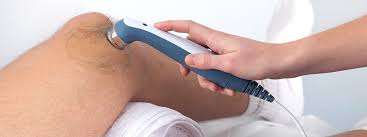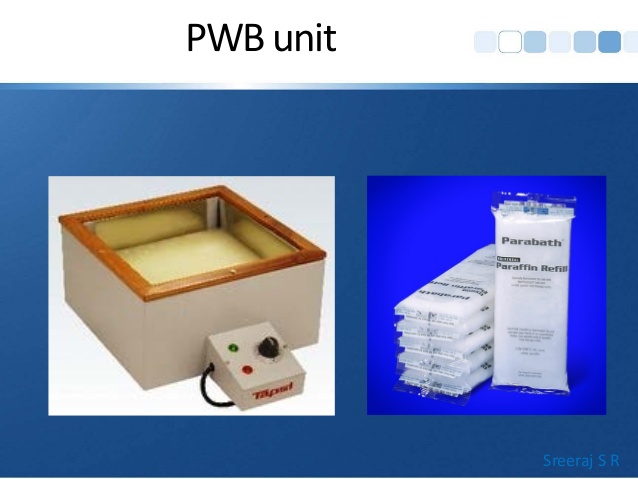Use of UVR Therapy in Physiotherapy : Ultraviolet Therapy
Table of Contents
Introduction of UVR :
~Ultraviolet radiation (UVR) has been used for many years in the treatment of both skin diseases and wounds. Much work has been carried out to evaluate its effects in disease.
~Ultraviolet radiation covers a small part of electromegnetic spectrum lying between the violet end of the visible light and X-RAY region.

~UVR are invisible to the human eyes.
~natural source of UVR is sun.
~UVR provokes chemical changes not simply heat at sites where they absorbed.
Types of UVR:
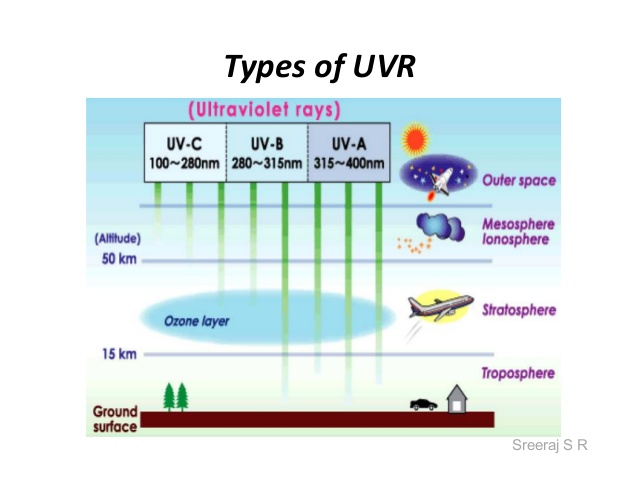
(1)UVA(long UV)400-315 nm (penetrates to dermis,responsible for develpoment of the slow natural tan)
(2)UVB(Medium UV,erythermel UV) 315-280 nm,(Produces new pigment formation,sunburn,vitamin D synthesis,responsible for inducing skin cancer)
(3)UVC(short UV,germicidel UV)280-100 nm, (does not reach the surface of the earth)
Production of UVR:
~Therapuetic UV produced by passage of a current through an ionized vapour often mercury vapour.
~at low pressure or high tempreture.
~devices are commonly used are either
~air cooled(using air circulation with fan)or water cooled (using a water jacket surrounding the burner with continually circulating water.)
Mercury Lamp:
~produced by mercury vapour lamp.
~which consists of the quartz burner tube containing traces of argon gas and mercury under reduced pressure.
~an electrode is inserted at each end of the burner tube.
Mercury vapour lamp:
~the current is applied to the electrodes,
~causes the formation of free mercury ions and electrons.
~whwn free electrons are accelerated in the tube, many collisions with neutral mercury vapour atoms will occur,
~by elastic collions not affecting the atom.
~by knocking an electron off the atom – ionization
Fluorescent lamps:-
~these are low pressure mercury discarge tubes with a phosphor coating on inside.
~the particular wavelengths and the amount of each emitted will depend on the composition of the phosphor used.
~this gives a considerable UVA ana UVB output but no UVC.
Alpine lamp:
~medium- pressure mercury arc lamp / high altitude lamp
~wavelength 253 nm (short wavelength ) used in treatment of generlised skin conditions as acne and psoriasis.
~short UVR react with oxygen in the air to produce a small quantity of ozone.
~ozone is toxic at high concentration so ventilation should be adequate around this lamps.
Krayomayer lamp:

~medium pressure mercury vapour designed to be used in contact with the tissues, both on the skin surface and in the body cavities.
~water cooled lamps,wavelength at 366 nm both give UVA and UVB.
~used for treating localised lesion as pressure areas ,ulcers,sheves, and sinuses in open area.
Theraktin tunnel:
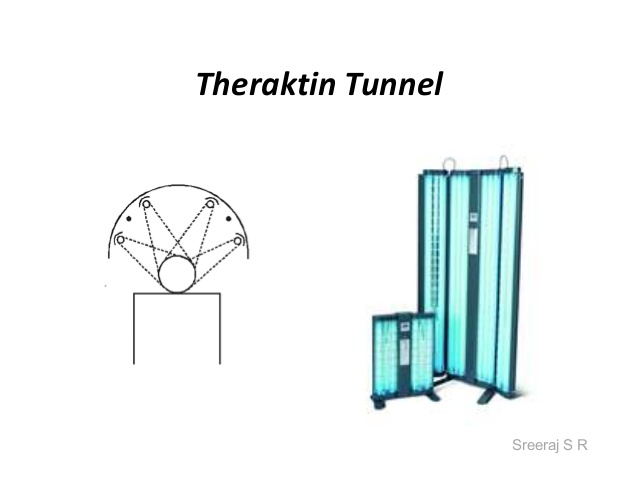
~Theraktin tubes consists of the number of flurorescent tubes each with a parabolic reflactor incorporated into a semicircular tunnel.
~the wavelength between the 290 nm to 350 nm used in treating affecting large areas.
~this provides an even iradiation to the patients.
~it allows treatment of the whole body in 2 halves.
~2 IRR elements are included in order to keep the patient warm in treatment.
~all of the lamps should be positioned at least 18″ from the patient.
~UVA- dermis level
~UVB-deep epidermis
Physiological effects:
~erythhema
~pigmentation
~increased skin growth
~vitamin D production
~esophylactic acid
~immunosuppresive effect
~effect on eye
erythema:
~erythema is reddning of the skin as a result of an inflammatory reaction stimulated by ultraviolet rays.
~release of histamine-like substance
~dilatation of capplliers and artioles and exudation of the fluid into skin.
Pigmentation:
~pigmentation or tanning of the skin follows the erythema.
~its amount varies with the intensity of the erythema.
~it is due to increased deposition of the pigment melanin formed in the basal cell layer of the skin by the melanoblasts , and migrats to the superficial layer of the epidermis.
disquamation:
~is the casting off of the cells which have been destroyed by the UVR.
~desquamation or peeling is propotinal to the intensity of the erythema.
vitamin D production:
~UVB is able to convert sterols in the skin,such as 7-dehydro cholesterol to vitamin D
~vitamin D is required to assist in the absorption of the calcium and phosphours from the intenstine to the blood stream.
The esophylactic acid:
~the resistance of the body to the infection is increased as a result of stimulation of reticuloendothelial system.
~antibodies against bacteria and toxins.
Immunosuppressive effects:
~UV destroys langeraharns cells and stimulates proliferation of supressor of T cells.
~(T cells are regulatory in that they inhibit antibody production)
~this emmunosupressive effects may contribute to the development of the skin cancer.
~in short, UV radiation induces a state of relative immunosuppresion that prevents tumor rejection.
effects on eyes:
~strong doses of UVB and C radiation to the eyes to can lead to conjuctivies and photokeratitis results in irritation of the eye, a feelling of grit in the eye,watering of the eye, a eversion to light (photophobia)
~in severe cases intense pain and spasm of eyelid may be present,this is known as snow blindness.
~while UVB and C are absorbed in the cornea, UVA can pass through to be absorbed mainly in the lense of the eye.
~the strong doses of the UVA can lead to formation of cataracts.
Solar elastosis & ageing:
~prolonged exposure of UVR lead to premature ageing of the skin,this is especially so in the fair skinned.
~decresed function of subceous and sweat glands.
~loss of elastic tissue.
~the skin becomes wrinkled,dry and leathery.
cancer:
~skin cancers,basal cells,and squmeous cell carcinomas.
~carcinogenesis is a danger ,as these rays may have an effect of DNA and thus on cell replication.
~shorter ultraviolet waves should be avoided and courses of treatment should not exceed four weeks.
UVR dosage:
~skin response to UVR depends upon
~quantity of UVR energy applied to the skin.
~biological responssiveness of the skin.
*quantity of UVR energy applied to the skin which depends upon:-
~(a)output of the lamp
~(b)distance between the lamp and the skin
~(C)angle at which radiation fall on the skin
~(d) time for which radiations are applied on the skin.
Biological responsiveness of the skin:
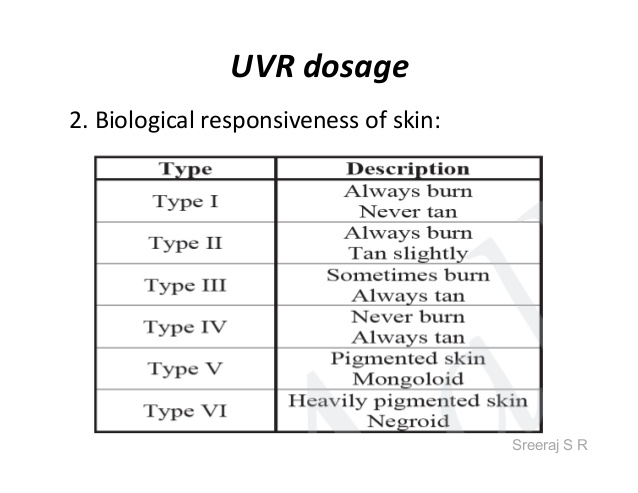
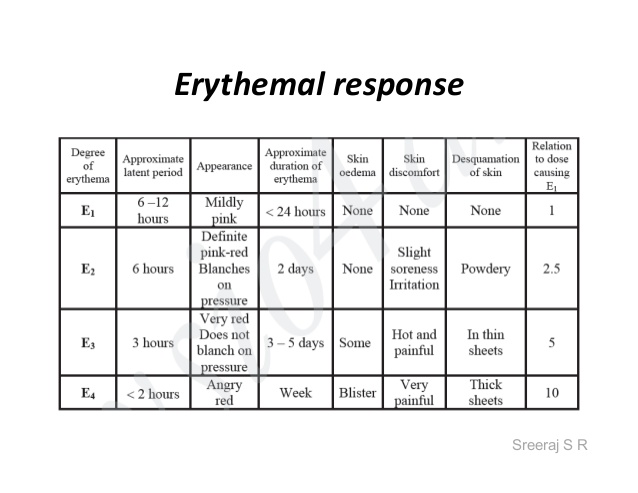
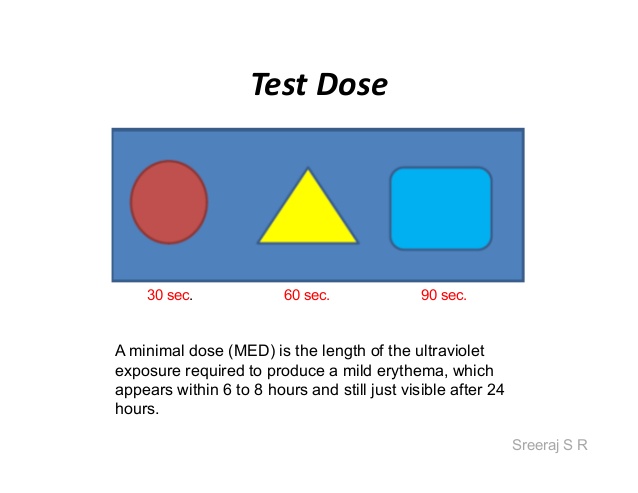
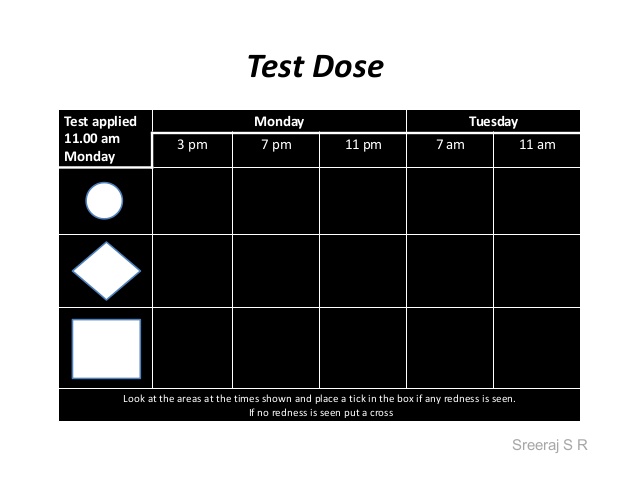
calculation of the dosage:
~E1 is determined from the skin test and the other erythemal dosages can be calculated as follows:-
~suberythemal of 75% of E1.
~E2=2.5.E1
~E3=5.E1
~E4=10.E1
~Double E4 =20.E1
~E4 and double E4 are used on open wounds.
Progression of UV dosage:
~doses can be progressed as follows:-
~suberythemal-previous dose plus 12.5%
~E1 =previous dose plus 25%
~E2=previous dose plus 50%
~E3=previous dose plus 75%
~dosages used on open wounds are not progressed because there is no epidermis to thicken.
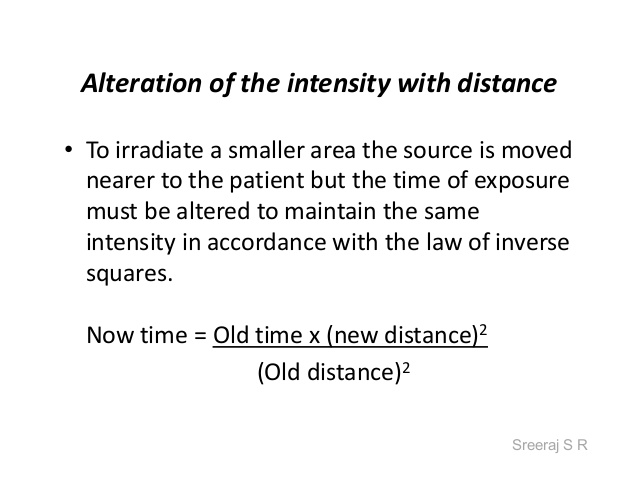
Therapuetic uses:
~psoriasis
~acne vulgaris
~eczema
~chronic infection
~protection for hypersensetive skin
~vitamin D deficipency
~mild hypertension
~pruritis
~pschycological benefits
~non infected wounds
~intact skin
Psoriasis:
~A skin conditions which presents, localized plaques in which rate of cell turnover from the basal layer through to the superficial layer is too rapid.
~the aim of ultaviolet irradiation is to decrease the rate of DNA synthesis in the cells of the skin and thus slow down their proliferation.(immunosupressive effect of UVR)
Acne vulgaris:
~this is a chronic inflammatory condition of the pilosebaceous unit especially affecting the face ,chest and back.
~using UVR is aiming to produce desquamation to open the blocked pores and hair follicles.
~usually E2 are used.
Eczema:
~an inflammatory response in the skin ,with associated oedema,itching with redness,scalling,vesicles and exudation of serum on the skin.
~it may be caused by contact dermatitis,atopic eczema .
~it is often these who can benefit from mild ultraviolet treatment.
Infected wound:
~treated with high doses of ultraviolet radiation.
~a krayomayer lamp is sucessfull in inhibiting bacteril colony growth.
~the dose must be given is E4.
Non infected wound:
~the aim of ultraviolet radiation is to stimulate the growth of granulation tissues and thus speed up repair.
~can be used in surgical incisions,pressure areas,venous and arterial ulcers.
~UVA and E3 Dose is sufficient.
Incipient pressure areas:
~UVR may be prevent pressure areas from breaking down and stimulate the growth of epithelial cells and to destroy the surface bacteria.
~E1 dose progressed daily using the krayomayer lamp.
~in areas such as the heels or elbows where the skin is thicker,and E2 may be used.
Vitilligo:
~an autoimmune disease in which destruction of melanocytes in local areas causes white patches appear on the skin.
~both UVA and B stimulate melanocytes activity.
~UVA seems to provoke a darker and long lasting tan although the protective effects do not seem to be so marked.
~UVB provokes more thickening
Protection for hypersensetive skin:
~polymorphic light eruption is the commonest of photodermatoses.
~increased tolerance to sunlight can be achived by a source of UVB.
~starts with a very low dose and gradually progressing.
Vitamin D deficiency:
~vitamin D3 is formed in skin by the action of UVB and C on 7-dehydrocholesterol.
~natural sunlight can also be curative for vitamin D defeciency diseases.
~by moving an electron to a higher energy level – excitation
Mild hypertension:
~the general erythermal doses of UVB can significantly lower blood pressure.
~it is belived to be due to calcium regulating hormones associated with increased vitamin D production.
Pruritus:
~the intractable and serious itching that can occur due to raised bile acid level in billiary cirrhosis or uraemia.
~can sucessfully treated by suberythemal whole body UVB either alone or in combination with the drug cholestayramine.
Pscyological benefit:
~patients expect to be feel better and consequent tanning makes them look better.
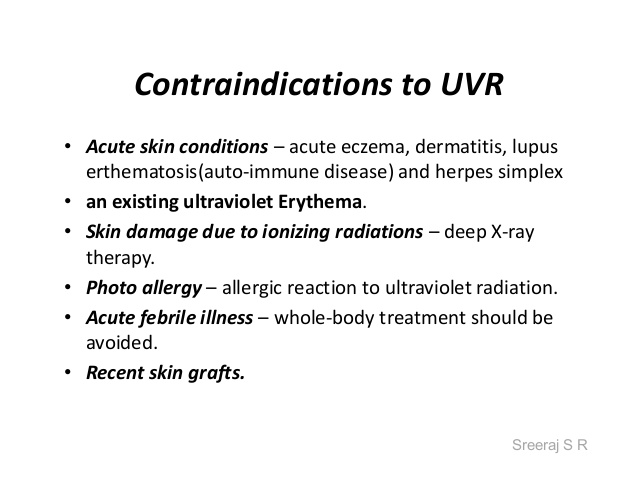
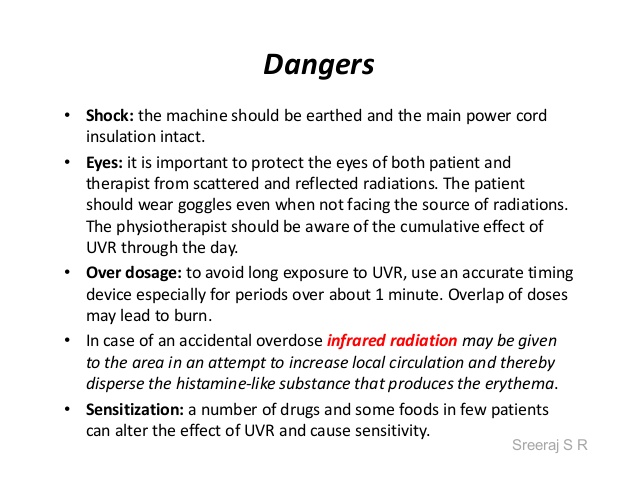
Other Electrotherapy Modalities Related Post :

